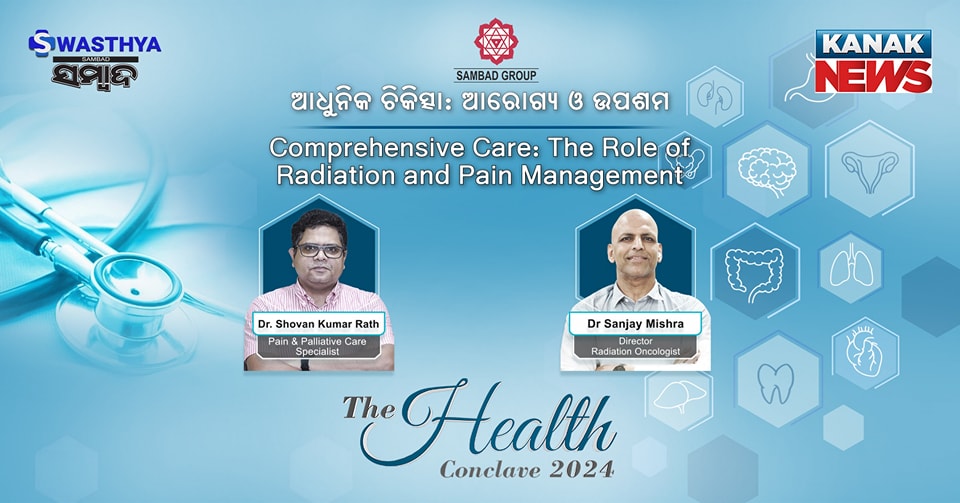Comprehensive care in healthcare involves addressing the multifaceted needs of a patient, considering not only the disease but also the physical, emotional, and psychological aspects of treatment. In this context, radiation therapy and pain management play critical roles, especially in the treatment of cancer and other serious conditions. Below, we will explore the importance of both radiation therapy and pain management within comprehensive care, focusing on their use in treating disease, improving quality of life, and managing treatment side effects.
In the second panel discussion of The Health Conclave, Dr Sanjay Mishra and Dr Sovan Kumar Rath discussed on role of radiation therapy and pain management in comprehensive care. Here are the key points from the discussion.
1. Radiation Therapy: Role in Treatment and Comprehensive Care
Radiation therapy is a powerful tool in the treatment of various cancers and some non-cancerous conditions. It uses high-energy rays or particles to destroy or damage cancer cells, prevent tumor growth, and shrink tumors. Radiation can be delivered externally (external beam radiation) or internally (brachytherapy).
Key Roles of Radiation Therapy in Comprehensive Care
a. Curative Treatment
Radiation therapy is often used as a primary or adjuvant treatment for cancers that are localized or have not spread beyond a certain point. In these cases, radiation can completely destroy cancer cells and cure the disease. Examples include:
- Breast Cancer: After surgery (lumpectomy), radiation may be used to kill any remaining cancer cells in the breast tissue.
- Prostate Cancer: In cases where surgery isn’t an option or as part of a combined approach, radiation can be used to treat localized prostate cancer.
- Head and Neck Cancers: Radiation therapy is often combined with chemotherapy to treat cancers in the mouth, throat, or nasal passages.
b. Palliative Care and Symptom Relief
In advanced cancers, radiation therapy is often used to manage symptoms and improve the quality of life when a cure is not possible. This is called palliative radiation therapy. Key symptoms that radiation can alleviate include:
- Pain: Radiation can shrink tumors that are pressing on nerves or bones, thus reducing pain.
- Bleeding: For cancers that cause bleeding (e.g., in the airway or gastrointestinal tract), radiation can help stop or reduce the bleeding.
- Obstruction: For cancers that block airways (e.g., lung cancer), radiation can reduce tumor size to ease breathing difficulties.
- Nausea and Vomiting: In certain cases, radiation therapy can be used to treat tumors causing digestive or gastrointestinal obstruction.
c. Combination Therapy
Radiation is often used in combination with surgery, chemotherapy, or immunotherapy. This multi-modal approach allows clinicians to attack cancer cells from different angles, improving outcomes and increasing the chances of remission. For instance:
- Chemoradiation: Radiation therapy combined with chemotherapy can be more effective than either treatment alone in certain cancers, such as head and neck cancer or cervical cancer.
- Post-Surgical Radiation: After a surgical procedure, radiation may be used to ensure any remaining microscopic cancer cells are destroyed, reducing the risk of recurrence.
d. Side Effects of Radiation
While radiation therapy can be highly effective, it is not without potential side effects. These can vary depending on the type of cancer, the area being treated, and the individual’s overall health. Common side effects of radiation include:
- Fatigue: A common side effect that can last for weeks after treatment.
- Skin Irritation: Redness, dryness, or soreness of the skin in the treated area.
- Nausea: Particularly with radiation directed at the abdomen or pelvic area.
- Hair Loss: May occur in areas where the radiation is focused, such as the head or chest.
These side effects are often temporary and can be managed with supportive care and medications.
2. Pain Management: Enhancing Quality of Life
Pain is a common symptom of both cancer and its treatments. Comprehensive care for pain management involves a multidisciplinary approach, including medications, physical therapy, psychological support, and alternative treatments to alleviate discomfort and enhance the patient’s quality of life. Effective pain management not only improves physical comfort but also has significant emotional and psychological benefits, reducing anxiety, depression, and the overall burden of illness.
Key Strategies in Pain Management
a. Pharmacologic Pain Management
- Opioids: These are the mainstay for moderate to severe cancer pain. While effective, opioids must be used cautiously due to their potential for addiction and side effects such as constipation, nausea, and sedation.
- Common opioids used in cancer pain include morphine, oxycodone, and fentanyl.
- Adjuvants: Medications that may not directly target pain but can help in specific pain situations. These include:
- Antidepressants (e.g., amitriptyline) for nerve pain.
- Anticonvulsants (e.g., gabapentin) for neuropathic pain.
- Steroids (e.g., dexamethasone) to reduce inflammation and control pain caused by swelling.
- Non-Opioid Analgesics: Over-the-counter medications such as acetaminophen or nonsteroidal anti-inflammatory drugs (NSAIDs) can be used for mild to moderate pain and to complement opioid therapy.
- Topical Analgesics: Creams, gels, or patches containing local anesthetics (e.g., lidocaine) can be used for localized pain, especially in cases of skin or nerve-related pain.
b. Interventional Pain Management
For certain types of pain, especially in advanced cancer, more direct interventions may be necessary:
- Nerve Blocks: Involves the injection of local anesthetics or steroids to block pain signals from specific nerves.
- Epidural or Intrathecal Drug Delivery: Pain-relieving medications, including opioids, can be delivered directly into the epidural or spinal fluid, allowing for more effective pain control with lower doses.
- Radiation Therapy: As mentioned, radiation therapy can be used to treat tumors causing pain or discomfort, such as those pressing on nerves or bones.
c. Complementary and Alternative Therapies
In addition to pharmacological and interventional methods, complementary therapies can play an important role in managing pain and improving well-being:
- Acupuncture: Involves the insertion of fine needles at specific points in the body and has been shown to help manage cancer-related pain and reduce the need for opioids.
- Massage and Physical Therapy: Gentle massage and physical therapy can improve circulation, reduce muscle tension, and alleviate pain, particularly in patients with bone pain or musculoskeletal issues.
- Mind-Body Techniques: Practices such as yoga, meditation, and mindfulness have been shown to help reduce pain perception and promote relaxation.
d. Psychosocial Support
Living with chronic pain can take an emotional toll. A comprehensive pain management approach includes psychological support to help patients cope with the emotional and mental challenges of living with pain. This may include:
- Cognitive Behavioral Therapy (CBT): A form of talk therapy that helps patients change negative thought patterns about pain and develop better coping strategies.
- Counseling and Support Groups: Connecting patients with peers or mental health professionals can help reduce the isolation and anxiety often associated with chronic pain.
3. The Role of Comprehensive Care Teams
Both radiation therapy and pain management are most effective when delivered as part of a multidisciplinary care team. These teams typically include:
- Oncologists (specializing in cancer treatment),
- Pain specialists (focused on managing pain),
- Radiologists (experts in administering radiation),
- Nurses (providing day-to-day care and emotional support),
- Psychologists or counselors (for emotional and mental health support),
- Physical therapists (for rehabilitation and mobility support).
By working together, these professionals can provide a holistic treatment plan that addresses the patient’s medical, emotional, and psychological needs, optimizing treatment outcomes and quality of life.




